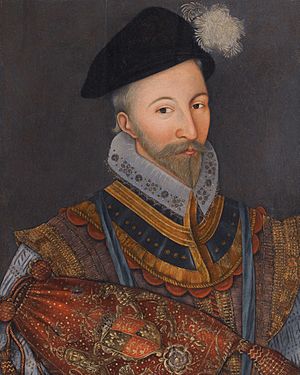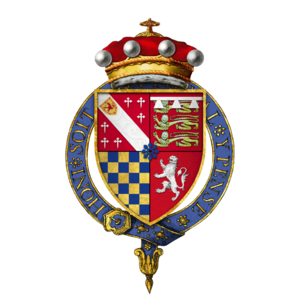William Howard, 1st Baron Howard of Effingham facts for kids
Quick facts for kids
The Lord Howard of Effingham
|
|
|---|---|

William Howard (circa 1510-1573), 1st Baron Howard of Howard of Effingham
|
|
| Born | 1510 |
| Died | 12 January 1573 (aged 62–63) |
| Noble family | House of Howard-Effingham |
| Spouse(s) | Katherine Broughton Margaret Gamage |
| Issue | Agnes Paulet, Marchioness of Winchester Charles Howard, 1st Earl of Nottingham Sir William Howard Edward Howard Henry Howard Margaret Howard-married Richard Allen Hinson Douglas Sheffield, Lady Sheffield Mary Sutton, Lady Dudley Frances Seymour, Countess of Hertford Martha, Lady Bourchier Katherine Howard |
| Parents | Thomas Howard, 2nd Duke of Norfolk Agnes Tilney |
William Howard, 1st Baron Howard of Effingham (around 1510 – 12 January 1573) was an important English diplomat and military leader. He worked for four different monarchs: Henry VIII, Edward VI, Mary I, and Elizabeth I. He held many important jobs, like going on diplomatic missions to other countries. He also served as Lord Admiral (in charge of the navy) and Lord Chamberlain of the Household (a senior official in the royal household).
Contents
Early Life and Family
William Howard was born around 1510. He was the ninth son of Thomas Howard, 2nd Duke of Norfolk. His mother was Agnes Tilney, who was the Duke's second wife. William was the oldest son from this second marriage.
He received a good education at Trinity Hall, Cambridge. After finishing his studies, he joined the royal court at a young age. This meant he started working for the King.
Diplomatic Missions
William Howard was often sent on important trips to other countries. These trips were called "embassies." His job was to represent the English King or Queen.
- In 1531, King Henry VIII sent him to Scotland.
- In 1532, he went with King Henry to Boulogne, France.
- In 1533, he helped at the coronation of his niece, Anne Boleyn. She became Queen Anne, King Henry VIII's second wife. William even carried a canopy over his great-niece Elizabeth (who later became Queen Elizabeth I).
- In 1534, he went to Scotland again. He was asked to get the measurements of the Scottish King, James V. This was so Henry VIII's tailor could make James a new suit as a gift. Howard also tried to arrange a meeting between the two kings.
- In 1535, he returned to Scotland to give James V a special award called the Order of the Garter. He also brought gifts of "great horses." The Scottish Queen, Margaret Tudor, said James V "liked him very well."
- He also went to France several times to talk with French leaders. In 1539, he was among those who welcomed Anne of Cleves, King Henry VIII's fourth wife, when she arrived in Calais.
In 1541, William Howard faced a difficult time. He was accused of not reporting some issues related to his young niece, Catherine Howard, who was King Henry VIII's fifth wife. He was called back to England and briefly faced legal trouble. However, he was pardoned and released after a short time.
Military Service
William Howard also had an important military career. He was involved in several battles and naval operations.
- In 1544, he joined the English forces that invaded Scotland. He was part of the fighting in Edinburgh.
- Later that year, he helped in the siege of Boulogne in France.
- In 1545, he was ordered to serve "upon the seas." This meant he was in charge of ships. He patrolled the English Channel and stopped foreign vessels.
- By 1546, he was called "vice-admiral." He was second-in-command to the Lord Admiral. When the Lord Admiral was busy, William Howard took command of the English fleet.
His career continued to grow. In 1552, he became the Lord Deputy and Governor of Calais. This was a very important position. He also joined the Privy Council, a group of trusted advisors to the monarch.
When King Edward VI died in 1553, William Howard supported Queen Mary I. He held Calais for her against those who wanted Lady Jane Grey to be queen.
Important Roles Under Queen Mary I
Queen Mary I rewarded William Howard for his loyalty.
- In 1554, he was appointed to meet Spanish ambassadors. They came to London to discuss Queen Mary's marriage to Philip II of Spain.
- He helped defend London during Wyatt's rebellion. He held a key city gate, stopping the rebels from entering. This helped end the rebellion.
- On 11 March 1554, he was given the title of Baron Howard of Effingham. This made him a noble.
- On 20 March 1554, he became the Lord Admiral, the highest naval officer.
- In October 1554, he was made a Knight of the Garter, a very special honor.
As Lord Admiral, he led a fleet of 28 ships to meet King Philip II when he arrived in England in 1555. He also escorted King Philip to Flanders. In 1557, his fleet transported English forces to Calais.
Later Years and Legacy
When Elizabeth became Queen in 1558, William Howard continued to serve the Crown.
- He became the Lord Chamberlain of the Household, another very important role in the royal court.
- He was also appointed to the Privy Council again.
- In 1559, he helped negotiate an important peace treaty called the Treaty of Cateau-Cambrésis.
- He received honorary degrees from both Cambridge and University of Oxford universities.
William Howard was a regular attendee at Privy Council meetings throughout the 1560s. By late 1572, his health declined, and he could no longer perform his duties as Lord Chamberlain. Queen Elizabeth appointed him Lord Privy Seal instead.
William Howard died at Hampton Court Palace on 12 January 1573. He was buried in Reigate.
Today, Whitgift School stands on the site of his former estate in Croydon. There is a portrait of Lord Howard by Daniël Mijtens at Nostell Priory.
Family Life
William Howard was married twice.
His first wife was Katherine Broughton. They married before June 1531. Katherine died in 1535. They had one daughter:
- Agnes Howard, who married William Paulet.
His second wife was Margaret Gamage. They married in June 1535. Margaret was the daughter of Sir Thomas Gamage. William and Margaret had four sons and five daughters:
- Charles Howard, 1st Earl of Nottingham (who became a very famous naval commander)
- Sir William Howard
- Edward Howard
- Henry Howard
- Douglas
- Mary
- Frances
- Martha
- Katherine


